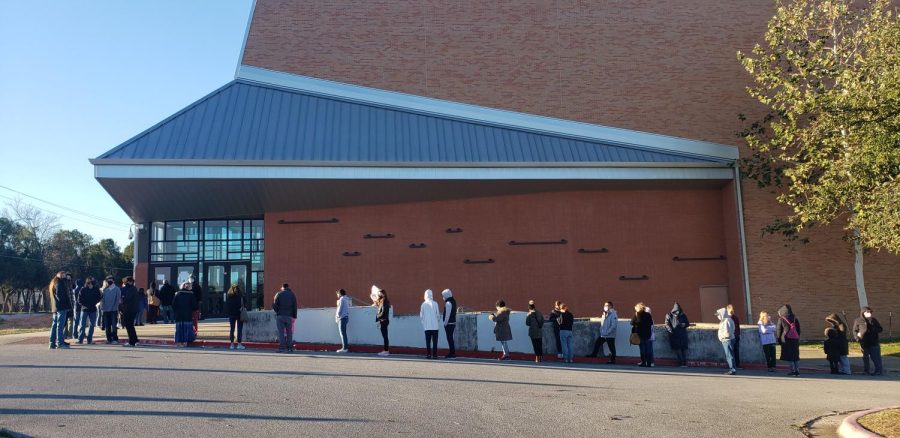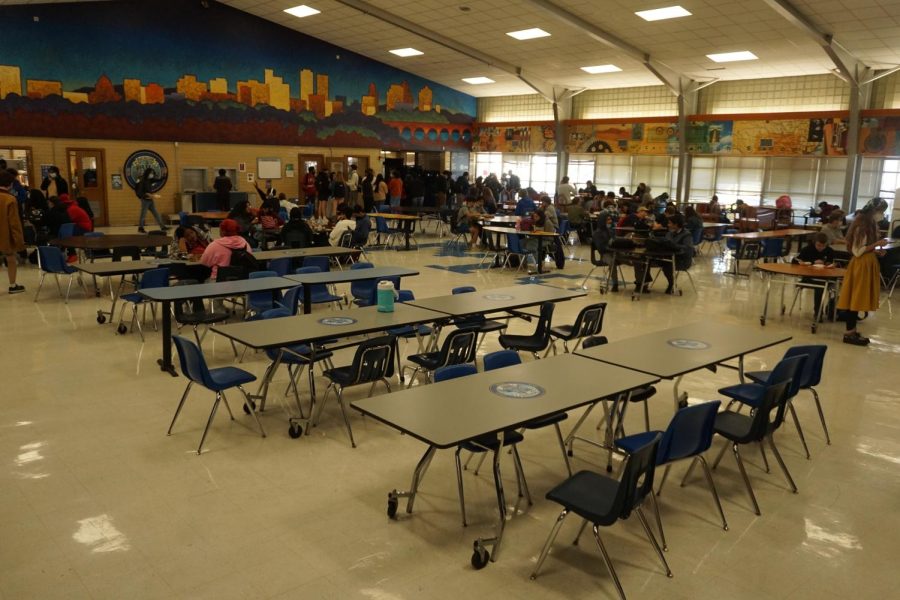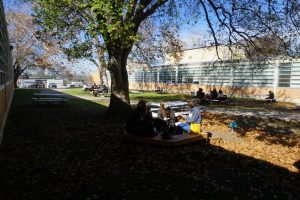Tide begins going out on recent omicron wave
As COVID mitigation procedures at school continue, health experts urge vigilance, predict light at end of tunnel
Cafeteria tables sit empty at lunch after Austin Public Health declared that Austin-Travis County had returned to a Stage 5 risk factor.
January 31, 2022
In recent weeks, total COVID-19 cases at McCallum more than tripled compared to last semester. Now, health experts predict that the worst is over as the omicron surge begins to subside, both nationwide and in Austin.
Dr. Mark McClellan is the director of the Duke-Margolis Center for Health Policy at Duke University and the former head of the Food and Drug Administration. With his eye on falling cases nationwide, Dr. McClellan continues to recommend diligence in mitigation efforts.
“We’re still in a tough spot right now, because even though cases are starting to come down, including in Texas, the hospitalizations and the burden on our health care system lags behind,” Dr. McClellan said. “So it’s still really important now, even as things are starting to look better, for people to be careful about taking steps to prevent transmission.”
To help prevent transmission at McCallum, assistant principal Andy Baxa leads the contact-tracing team. Last semester, he handled all contact tracing on his own, but as cases surged this semester, additional administrators joined the effort to stay on top of the caseload. According to principal Nicole Griffith, this may or may not be a permanent change.
“I foresee us needing to continue to evolve in how we approach COVID,” Griffith said.
Baxa said that for the moment, the administrative team has its hands full.
“We’re all doing our full-time jobs, and contact tracing is a full-time job,” Baxa said. “And so, we’re basically doing two full-time jobs, and trying to keep up with everything.”
Baxa said that a majority of contact tracing is coming out in 1–2 days, but delays can happen due to the stress of this extra workload on the administrative team.
“Everybody is doing the best they can, and sometimes, we don’t have the power to get to every single case in the manner that we want to get to it,” Baxa said. “And so, unfortunately, there have been some members of our team that haven’t been able to keep up at the same pace as some of the others, but they are catching back up, and they’re doing their best to keep up with all the demands of it.”
Baxa himself has found it difficult to juggle all of these responsibilities on top of his usual administrative duties. He makes an effort to send out letters to parents with caseload updates, but the frequency of those letters has decreased this semester.
“Do I take 30 minutes to an hour to work on letters, or do I spend that time working on COVID contact tracing and working on direct communications?” Baxa said. “Unfortunately, sometimes the letters do get kind of pushed to the back burner, because there’s more timely stuff that I need to address, and at the end of the day, I just need to get some sleep.”
Now, as cases continue to drop, the load may be lightening for the contact-tracing team. After multiple COVID-case updates to parents went out in seven-day intervals, recent letters are coming out within a day or two of each other. The most recent letter reported 15 new cases on Jan. 31. After a lot of time spent on contact tracing, Baxa has found that a majority of the spread isn’t happening in the classroom.
“If I had to say where campus spread is occurring, it’s not so much the classroom, it’s more so lunch and after school,” Baxa said. “Kids are great about wearing their masks here, but we know that when they leave here, it doesn’t always stay on the way it does here in school.”
While Baxa understands the realities of what happens when kids leave campus, he asks that students remain mindful about the risks they might be creating.
“That’s where a lot of the spread is happening among our student body,” Baxa said. “Whenever they’re hanging out with each other after school, hanging out with each other on the weekends, still going to parties, still doing the high school thing. And, again, I don’t think anybody should ever live in fear, but just be mindful. Be mindful of little mitigation things you can do that could have a huge impact. If you miss one party, is it the end of the world?”
To minimize contacts at school that can’t be tracked, Flexible Instruction Time is postponed while the county is in a Stage 5 risk factor. Additionally, directors are making extra efforts to mitigate the spread. On Jan. 20, the band canceled its annual Mardi Grazie concert, a major fundraising event, over concerns surrounding COVID transmission. Some coaches have followed suit and adjusted practice schedules in response to increased caseload.
“With JV, we’ve had numerous cases,” boys basketball coach Carlin Shaw said. “I know when we came back from the semester, we had about eight of the 15 guys out, so for that first game, we played with, like, seven guys available. But we’ve worked around it. We’ve practiced with the freshmen, kind of combined practices, to make it work.”
On Jan. 11, Austin ISD updated its recommendations for indoor sporting events in response to Travis County returning to the Stage 5 risk factor. Under these new guidelines, crowds are limited so that only two guests per player can attend games. Coach Shaw said that although these guidelines aren’t great for morale, he’s thankful that guests are able to attend at all.
“At least it’s not like last year,” Coach Shaw said. “Then, even their parents couldn’t come. So it was just like playing in an empty gym. But this year, even with the two guests, it still gives them somebody to look at and some kind of energy.”

With teachers, coaches and directors doing their part, Baxa is confident that as a whole, the community is doing its best to allow the omicron variant to recede. Now, as cases begin to decrease throughout Austin, Baxa is hopeful that this new trend will hold steady at McCallum as well.
“We see signs that we may have reached the peak of our wave,” Baxa said. “So, we’ll see. I can definitely say I’ve seen spread decrease, I’ve seen cases decrease, so let’s pray that’s the trend and not just a blip.”
Now, Dr. McClellan recommends remaining vigilant and getting tested in order to stay on top of transmission.
“Cases are starting to fall in many places around the country, and with that, the PCR labs are getting less backed up,” Dr. McClellan said. “And that’s probably going to be the most important thing, so that’ll change in the next few weeks around the country.”
This increased testing availability is a big change following sweeping supply shortages of at-home rapid tests. Chris Johnson, McCallum parent and owner of the local MedSavers pharmacy, experienced these shortages first-hand.
“In the beginning, I noticed this was getting ready to happen, and so I ordered up as much as I could order,” Johnson said. “I did everything that I could do to procure as many tests as I could from my wholesalers, and over the course of a couple of weeks, I think we went through close to 8,500 tests, out of this little pharmacy that we have. And we finally did run out.”
Supply is picking back up, but if students are unable to purchase at-home tests, McCallum is host to one of 12 AISD testing hubs, which is located in the MAC and is open from 8 a.m. to 2 p.m. on weekdays. Baxa is thankful that students often take advantage of this easily accessible opportunity to get tested.
“I’d rather see that a lot of kids that are testing are testing before symptoms ever develop,” Baxa said. “They’re getting asymptomatic test results—and being removed from the school and reducing the spread opportunity—that we wouldn’t know about if that testing hub wasn’t there.”
Prior to the beginning of the semester, Austin ISD hosted back-to-school COVID-19 testing, which yielded a 14.5% positivity rate, according to the district website. The antigen testing led to a lower positivity rate than PCR testing in Austin-Travis County at large, which revealed a 34% positivity rate. These were signs that cases at McCallum were only going to go up.

Junior Jude Brandimarte and his mother, a teacher at Lamar Middle school, received the last two tests at the McCallum testing hub on Jan. 3 before tests ran out.
“The line was pretty long,” Brandimarte said. “There were a lot of parents with their kids there. We had to wait for a while, luckily not as long as others. Some said they had to wait, like, an hour and 40 minutes. Fortunately, me and my mom actually got the last two tests they had, but everyone else in line had to go somewhere else.”
The increase in testing as well as positive cases was a result of spread occurring over the break. As the omicron variant spread, people in Austin made efforts to safely see their families for the holidays. For senior Zara Terrazas-Graham, testing positive just a few days before Christmas threw a wrench in her plans.
“The first day I had symptoms, I was tired, I felt really sick, I was nauseous,” Terrazas-Graham said. “What was really bad was the joint pain. And then the next day, just a very low fever and chills, but joint pain. And on the third day, most of my symptoms were completely gone. It was really fast. But that first day was terrible—very, very, very uncomfortable.”
Now that she’s had omicron, Terrazas-Graham feels a bit more at ease.
“I don’t hang out with anyone who isn’t boosted, but I feel less of a pressure to wear a mask constantly,” Terrazas-Graham said. “I am still not a huge fan of being at school during Stage 5, but I know that if anyone’s at risk, it’s probably not me.”
Looking to the future, Dr. McClellan worries that further infections will give the virus an opportunity to mutate further.
“With so many people who don’t have good immunity, not just here, but around the world, that’s lots and lots of chances for mutation,” Dr. McClellan said. “And, chances are, we’re going to see another mutation happen in the future. Hopefully, they’ll keep getting less severe and more manageable, but it is something that you keep worrying about.”
More immediately, Dr. McClellan has high hopes for an end to this surge.
“Even if case rates are low, we don’t want to keep transmitting it,” Dr. McClellan said. “So, there will be tests available. If you do have symptoms, if you have been exposed, it will get a lot easier to find out if you’ve got COVID or not and act accordingly. If we all do that, we can get back to, I think, much more normal lives before too much longer.”









Amy Spiro • Feb 1, 2022 at 8:32 pm
Really an excellent, informative article. Much more thorough than what you get from the local media. Great job, Ms. Powers!